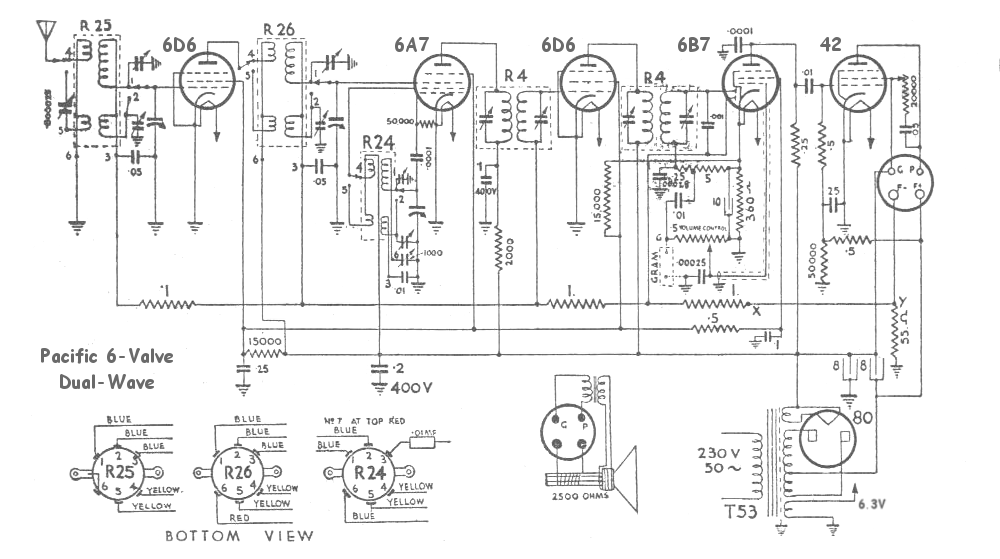Other radios based on the same chassis:

There were 7 main models of radio released by Pacific Radio Co. in 1935, or to be more precise there were 3 models of AC mains chassis (and several battery and vibrator models), fitted to one of 7 main cabinet styles (with the occasional oddball showing up in the mix).
The predominant chassis was the 6-valve dual-wave, with a 7-valve dual wave and a 5-valve broadcast version available as well.
Valves (5, 6 or 7):
5-valve Broadcast
6A7, 6D6, 6B7, 42, 80
6-valve dual wave
58, 2A7, 58, 2B7, 2A5, 80 (2.5V series)
6D6, 6A7, 6D6, 6B7, 42, 80 (6.3V series)
7-valve dual wave with RF sub-chassis
6D6, 6A7, 6D6, 6D6, 75, 42, 80
Intermediate Frequency: 256kc/s (possibly 465kc/s in 7-valve?)
Frequency Bands: 2
Chassis Notes(most schematics can be clicked to download a full size version)
The 1934/35 range of Pacific radios were available in 5-, 6-, and 7-valve options (and some versions of battery sets as well). The 5-valve was broadcast-band only, while the 6 and 7 valve models were dual-wave. All were built by Radio Corporation of New Zealand in Wellington.
The most common was the 6-valve dual-wave chassis, in a near-standard 'baking pan' design, with dark metallic gold paint rather than the usual cadmium plating (this was the last year that this chassis colour was used). Also notable were the square 'tabs' on the corners of the chassis rather than the usual rounded corners found from the following year. The 5-valve option was probably similar / the same as the model 15, and the 7-valve is similar to one or other version of the model 11 7-valve chassis.
These were the first mainstream Pacific models with an aero (round) dial. On early versions this dial assembly is square behind a round escutcheon and has a flat clear plastic lens attached to the assembly. Later models use a simpler round assembly with just the dial riveted to a round ring, and the clear lens (which is slightly domed) is fitted into the escutcheon.
Electrically they are identical to the Courtenay 108 circuitry. The Courtenay uses 2.5V valves in all sighted models while the Pacific sets uses 2.5V valves only in the earliest examples, with most appearing to be fitted with 6.3V equivalent valves.

A common fault (aside from the usual things like capacitors) in this chassis seems to be the 55 ohm resistor (wirewound on a flat former and soldered to the speaker socket) going open circuit. Here you can see the simple fix for this, although it would pay to ensure the original resistor is not intermittent, as this could halve the resistance (and mess up the biasing of the set) if it cuts back in - cutting the wire on the former at one end and pulling it away from the rivet would ensure this doesn't occur.
General Construction Notes for Radio Corporation of New Zealand Ltd:
The first digit of the serial number typically indicates the year of manufacture of RCNZ chassis' (although not the decade - that requires a little knowledge of the valves, construction, etc). Sets from around 1934 onwards were often (but not always) constructed in a distinctive pressed 'baking pan' style chassis, seemingly unique to RCNZ.
Model codes beginning with a 0, for example the model 051, are Osram valve versions of the model without the leading 0. Technically the 0 should be an O (for Osram), however the digit 0 was used throughout the site before this fact was discovered.
The E suffix indicates a magic eye option is fitted (in models which were available with or without, such as the model 25).
A and B suffixes appear to be simply updates to the current model, R also appears to be simply an updated model ('R'edesign, perhaps?)
P indicates either a permanent magnet speaker version of a model which also came with an electromagnet speaker (the model 26 for example), or a portable model (like the model 694P). This suffix was used in the mid 50's when Radio Corp was changing over.
N and M indicated miniature valve versions of a model which started with all (or a mix, ie: model 5) of larger valves. One of these two codes may indicate a transitional mixture of octal and miniature - clarification is required.
S often indicates a stereo model. It can also indicate 'self-biased' in the transition period between back-biased and self biased sets where there were models with both methods employed (53S for example)
Finally, other suffixes and prefixes make occasional appearances in the RCNZ lineup - like the 66W (a variant of the long-running model 66) and the 75XA (a 10-valve version of the model 75 with a separate amplifier chassis).
Model nicknames are often sourced from either newspaper advertising, company literature or the NZ Radio Traders Federation official trade-in price books (Particularly Courtenay models from this publication)
In 1954, model numbering changed, to begin with the number of valves (ie: 501 - 5 valves, 1006 - 10 valves, etc) although the final 2 digits don't appear to have much significance. Middle digits of 5 (portable) or 6 (mantle, including clock radio) are used on the AWA-designed plastic-cased sets.